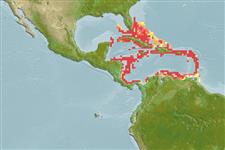Common names from other countries
>
Eupercaria/misc (Various families in series Eupercaria) >
Lutjanidae (Snappers) > Apsilinae
Etymology: Apsilus: Greek, apsilos, -e, -on = hairless, shorn, peeled (Ref. 45335).
More on author: Guichenot.
Environment: milieu / climate zone / depth range / distribution range
Ecologia
marinhas associadas(os) a recifes; intervalo de profundidade 40 - 300 m (Ref. 129909), usually 120 - 180 m (Ref. 55). Tropical; 29°N - 8°N, 98°W - 59°W
Western Central Atlantic: West Indies, Florida Keys, western Gulf of Mexico, western Caribbean (off Belize), probably more widespread in Caribbean (Anderson, pers. comm.).
Length at first maturity / Tamanho / Peso / Idade
Maturity: Lm 40.0 range ? - ? cm
Max length : 65.0 cm TL macho/indeterminado; (Ref. 55); common length : 40.0 cm TL macho/indeterminado; (Ref. 55); peso máx. Publicado: 3.2 kg (Ref. 40637)
Espinhos dorsais (total): 10; Raios dorsais moles (total): 9-10; Espinhos anais 3; Raios anais moles: 8. The snout is relatively short and pointed. Anterior teeth in upper jaw enlarged, canine-like. Interorbital space convex. Dorsal and anal fin bases without scales. Pectoral fins long reaching level of anus. Scale rows on back parallel to lateral line. The back and upper sides violet or dark brown becoming lighter ventrally. Juveniles are mainly blue in color.
Adults inhabit mainly rocky bottoms. Young sometimes found near the surface. Feed on fishes and benthic organisms, including cephalopods and tunicates. Flesh of good quality; marketed fresh and frozen.
Life cycle and mating behavior
Maturidade | Reprodução | Desova | Ovos | Fecundidade | Larvas
Allen, G.R., 1985. FAO Species Catalogue. Vol. 6. Snappers of the world. An annotated and illustrated catalogue of lutjanid species known to date. FAO Fish. Synop. 125(6):208 p. Rome: FAO. (Ref. 55)
Categoria na Lista Vermelha da IUCN (Ref. 130435)
CITES (Ref. 128078)
Not Evaluated
Ameaça para o homem
Reports of ciguatera poisoning (Ref. 31172)
Utilização humana
Pescarias: pouco comercial
Mais informação
ReferênciasAquaculturaPerfil para aquaculturaEstirpesGenéticaElectrophoresesHereditariedadeDoençasProcessamentoMass conversion
Ferramentas
Relatórios especiais
Descarregue XML
Fontes da internet
Estimates based on models
Preferred temperature (Ref.
115969): 19 - 23.7, mean 22.2 (based on 12 cells).
Phylogenetic diversity index (Ref.
82804): PD
50 = 0.7500 [Uniqueness, from 0.5 = low to 2.0 = high].
Bayesian length-weight: a=0.01096 (0.00555 - 0.02168), b=3.02 (2.84 - 3.20), in cm Total Length, based on LWR estimates for this species & (Sub)family-body (Ref.
93245).
Nível Trófico (Ref.
69278): 4.1 ±0.52 se; based on food items.
Resiliência (Ref.
120179): Médio, tempo mínimo de duplicação da população 1,4 - 4,4 anos (K=0.3).
Fishing Vulnerability (Ref.
59153): Low to moderate vulnerability (28 of 100).
